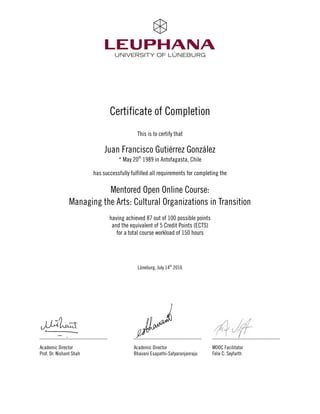managing-arts-certificate
•
0 likes•17 views
This certificate certifies that Juan Francisco Gutiérrez González completed an online course in managing cultural organizations. He achieved 87 out of 100 points, equivalent to 5 credit points for a total workload of 150 hours. The course introduced concepts for managing arts organizations within various contexts through case assignments. It covered responding to transitions, repositioning cultural industries, marketing cultural projects, leveraging stakeholders, digital branding, and developing sustainable strategies.
Report
Share
Report
Share
Download to read offline

Recommended
Presentation made at the Symposium on “Mainstreaming university-community research partnerships” at Indian Habitat Center on 9th April 2015, Organized by PRIA.Cristina Escrigas - Community based research Symposium PRIA India

Cristina Escrigas - Community based research Symposium PRIA IndiaPRIA (Society for Participatory Research In Asia)
Recommended
Presentation made at the Symposium on “Mainstreaming university-community research partnerships” at Indian Habitat Center on 9th April 2015, Organized by PRIA.Cristina Escrigas - Community based research Symposium PRIA India

Cristina Escrigas - Community based research Symposium PRIA IndiaPRIA (Society for Participatory Research In Asia)
More Related Content
Similar to managing-arts-certificate
Similar to managing-arts-certificate (20)
Against boundaries: Dismantling the Curriculum in Higher Education

Against boundaries: Dismantling the Curriculum in Higher Education
The really open university: working together as open academic commons

The really open university: working together as open academic commons
Intercultural Relations in Arts and Cultural Management

Intercultural Relations in Arts and Cultural Management
COMPANY WHITE CLAW HARD SELZERINSTRUCTION 6-7 PAGES (AN.docx

COMPANY WHITE CLAW HARD SELZERINSTRUCTION 6-7 PAGES (AN.docx
Determining the Position of Culture-Centered Design in Complementation of Urb...

Determining the Position of Culture-Centered Design in Complementation of Urb...
Social Innovation in Higher Education (Carmen Păunescu, Katri-Liis Lepik etc...

Social Innovation in Higher Education (Carmen Păunescu, Katri-Liis Lepik etc...
managing-arts-certificate
- 1. Certificate of Completion This is to certify that Juan Francisco Gutiérrez González * May 20th 1989 in Antofagasta, Chile has successfully fulfilled all requirements for completing the Mentored Open Online Course: Managing the Arts: Cultural Organizations in Transition having achieved 87 out of 100 possible points and the equivalent of 5 Credit Points (ECTS) for a total course workload of 150 hours Lüneburg, July 14th 2016 Academic Director Prof. Dr. Nishant Shah Academic Director Bhavani Esapathi-Satyaranjanraju MOOC Facilitator Felix C. Seyfarth
- 2. Managing the Arts: Cultural Organizations in Transition is a mentored open online course structured into six consecutive assignment phases. The course introduces learners to different theoretical concepts and practical approaches for managing and marketing arts and cultural organizations within various social, political and institutional contexts. While working in small teams on case-based assignments derived from real-life organizations in Berlin, Budapest, Bangkok and Lagos, learners collaborate within a global community and receive individualized mentoring by academic staff. More information at: http://digital.leuphana.com. Assignment 1: Responding to Transitions: Placing arts and cultural organizations in context: Learners took stock of social, political, economic, and cultural transitions on a global scale and their direct impact on the local existence and practices of arts and cultural institutions. Debating different conceptual definitions, learners identified the elements that create crisis and mapped the possibilities enabling the transitions for the respective case organization. Assignment 2: Repositioning Cultural Industries: Markets, marketing and the changing notions of art and culture practices: Learners explored how arts and cultural organizations can effectively reposition themselves, both to demands of new creative industries and also to address conditions of transition in the social and cultural orders. They learned to analyze organizations within relationships of the cultural market and understand how they sustain, develop and limit the radius of the institutions’ activities. Following the logic of analytical de-mapping, learners positioned an arts organization within ever-changing environments under conditions of the cultural market and corresponding policy frameworks. Assignment 3: Discovering Hidden Potential: Marketing cultural projects and managing artistic processes: Learners examined different practices of creativity using morphological analysis in order to understand various opportunities and challenges of arts and cultural management, in order to experiment with solution-driven processes for creative collaboration. Focusing on existing processes and practices pertaining to individual cultural projects, they outlined a sustainable vision for their case organizations. Assignment 4: Co-opting Multiple Stakeholders: Leveraging social capital for organizational growth: Learners focused on different stakeholders involved in the practices of arts and cultural organizations, identifying their impact and an appropriate level of engagement within the strategy of the organization. They also learned about low-cost digital options for audience interaction and relationship-building as well as multi-tiered approaches to communication with current and future stakeholders. Assignment 5: Exploring Emerging Identities: Co-creating and shaping digital brands: Learners reflected on remixed usage of proprietary content, digital replication, peer-to-peer sharing, and limits for controlling independent brand initiatives while managing potential repercussions. They performed a value analysis for their case organizations to outline sources of brand creation and management within network culture, leveraging the distributed branding and co-creation with external stakeholders and internal staff. Assignment 6: Building Solutions for the Future: Crafting sustainable artistic practices and programs: Building on previously created artefacts, learners developed a strategic project proposal for an integrated marketing campaign addressing crises for their case organization. They learned to identify and interpret resources underlying everyday practices into a coherent epistemology while considering the organization’s vision and scale, to calibrate a specific impact and to critically evaluate curatorial qualities. IN COOPERATION WITH